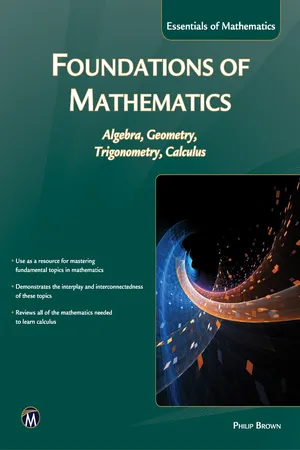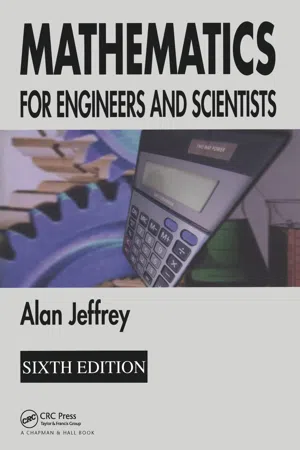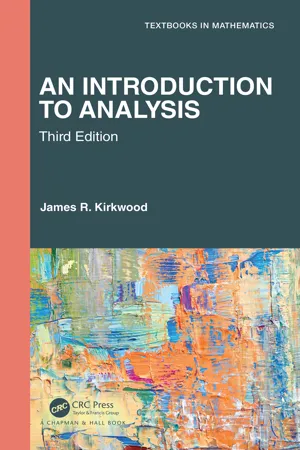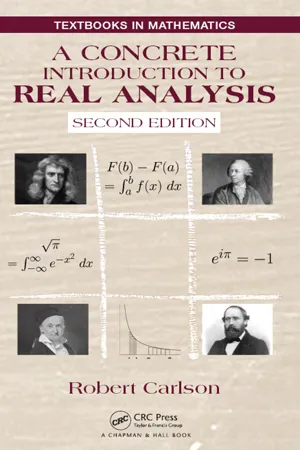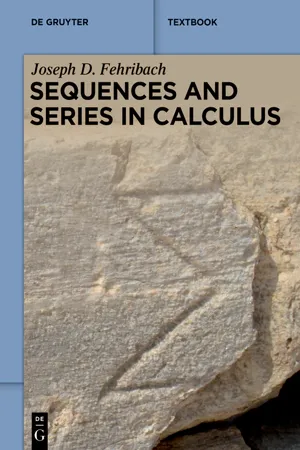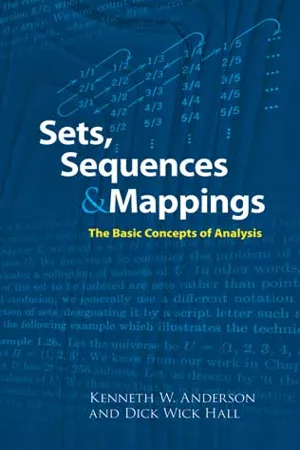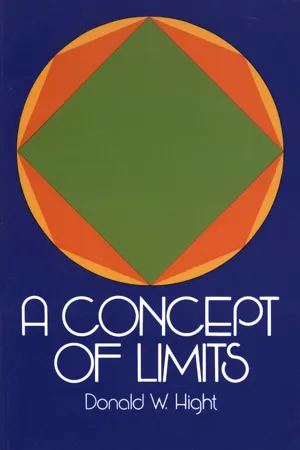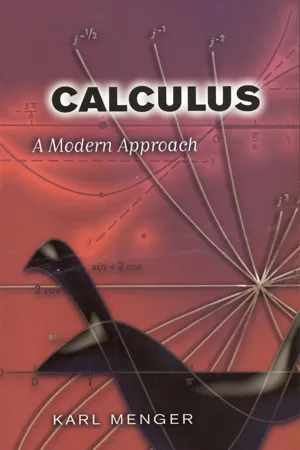Mathematics
Limit of a Sequence
The limit of a sequence is the value that the terms of the sequence approach as the index of the terms grows without bound. It represents the behavior of the sequence as it extends to infinity and is a fundamental concept in calculus and real analysis. The limit of a sequence can be finite, infinite, or may not exist.
Written by Perlego with AI-assistance
Related key terms
11 Key excerpts on "Limit of a Sequence"
- eBook - ePub
Foundations of Mathematics
Algebra, Geometry, Trigonometry and Calculus
- Philip Brown(Author)
- 2016(Publication Date)
- Mercury Learning and Information(Publisher)
can, in fact, be solved using basic algebra and taking a logarithm. Do it yourself!)Our conclusion is that the limit of the sequence is 1. The mathematical notation we use for this statement isThis should be read as: “The limit as n tends to infinity of an is 1.” This notation will be used again.EXAMPLE 7.3.2. As a variation of example 7.3.1 , consider the sequencewhich consists of the terms of the sequence in example 7.3.1 alternating with “1.” As in example 7.3.1 , for any given value x < 1, we can find an odd natural number N such that for any n ≥ N it is the case that x < an≥ 1. Therefore, we conclude again that the limit of the sequence is 1. (It does not matter that infinitely many terms of the sequence are also equal to 1.)EXAMPLE 7.3.3. As a variation of example 7.3.2 , consider the sequencein which all terms of the sequence beyond the fifth term are equal to 1. In this case, it is trivially true that x < an ≤ 1 if n ≥ 6, for any value x < 1, so here we conclude again that the limit of the sequence is 1.EXAMPLE 7.3.4 As another variation of example 7.3.1 , consider the sequence for which the first seven terms are as follows:The terms of this sequence alternately rise above and fall below the number 1. The limit of this sequence is also 1, but it is slightly more complicated to prove this using the method of example 7.3.1There are sequences that do not have a limit. Here is an example:EXAMPLE 7.3.5 Let for which the first seven terms areThe negative terms approach –1, whereas the positive terms approach 1, so the sequence has no limit. A great deal more can be said about sequences and limits of sequences, but now we move on to limits of functions.7.4. LIMITS OF A FUNCTION
The following three examples introduce what is meant, graphically, by the limiting value of a function f(x) if x approaches a particular value.EXAMPLE 7.4.1. The graph of a piecewise-defined function f(x) with different definitions to the left and right of x = 1 is shown in figure 7.3 - eBook - ePub
Approximating Perfection
A Mathematician's Journey into the World of Mechanics
- Leonid P. Lebedev, Michael J. Cloud(Authors)
- 2015(Publication Date)
- Princeton University Press(Publisher)
n looks likeIf we consider the term numbered n = 100, we get x100 = 1/100. For n = 1000 we get 1/1000, which is closer to zero; for n = 1000000 we get 1/1000000, which is even closer. The higher the index n, the closer the sequence term is to zero. Thus zero plays a special role for this sequence and is called the limit. In our example, the sequence terms decrease monotonically, but this does not always happen, and we can phrase the limit idea more generally by saying something like “the greater the index, the closer the terms get to the limit.” Cauchy proposed the following definition.Definition 1.1 The number a is the limit of the sequence {xn } as n → ∞ if for any ε > 0 there is a number N, dependent on ε, such that whenever n > N, we get |xn – a| < ε. A sequence having a limit is called convergent, and one having no limit is called nonconvergent. If a is the limit of {xn }, then we writeor xn → a as n → ∞.Note that if we consider a stationary sequence — that is, a sequence whose elements xn = a for all n — then by definition a is the limit. This supports our view of the limit as a value approached more and more closely as the index n increases.Let us carefully consider the limit definition from several points of view, because it is the central definition of the calculus and of continuum physics. First, there is the requirement “for any ε > 0”. The word “any” is dangerous in mathematics. In this context, it means that if we are to verify that a sequence has limit a, we must try all positive values of ε without exception; for each ε > 0, we must be able to find the number N depending on ε mentioned next.At first glance, we appear to have gained nothing: we started with an infinite process of either convergence or nonconvergence to a limit, and have replaced it by another, apparently infinite, process that forces us to seek a suitable N for every possible positive number ε. Note that it can be described as follows. We take some sequence of values εk tending toward zero, and for each of these find an N(εk ). It is clear that if we find N(ε1 ) then this N can be taken for all ε > ε1 . Thus we need not consider the continuous set of all ε > 0. Moreover, although the definition states that we should verify the property for all ε, our serious work begins with those that are close to zero. But the new process need not be infinite: we can find an analytical dependence of N on ε - eBook - ePub
- Richard Johnsonbaugh, W.E. Pfaffenberger(Authors)
- 2012(Publication Date)
- Dover Publications(Publisher)
IVSequences of Real NumbersAnalysis is concerned in one form or another with limits. We begin our study of real analysis with the study of limits of real sequences.10. Limit of a Sequence
Let X be a set. A sequence of elements of X is a “list” of elements from the set X. In this chapter we will be concerned with sequences of real numbers. We first make the notion of sequence precise.Definition 10.1 Let X be a set. A sequence of elements of X is a function from the set of positive integers into X.In particular, a real sequence (or sequence of real numbers) is a function from P into R. The usual notation for a real sequence is , where a denotes the function from P into R and anis the value of the function at the positive integer n. The notations a1 , a2 , . . . and {an} are also used to denote a real sequence. The number anis called the nth term of the sequence .A sequence may be defined by giving an explicit formula for the nth term. For example, the formuladefines the sequence whose value at the positive integer n is 1/n. The first three terms of this sequence areA sequence may also be defined inductively. Thus equations define the sequence whose first six terms areConsider the sequence whose nth term is defined by the formulaThe first four terms of this sequence areThe terms corresponding to n = 100, 101, 102 arewhich are close to 1. For example, differs from 1 by only . It is clear that n/(n + 1) is “close to” 1 “for all large positive integers n.” For this reason we say that the sequence has limit 1. In general, we say that a sequence has limit L if anis “close to” L “for all large positive integers n.” To define the Limit of a Sequence, we need to make the concepts “close to” and “for all large positive integers n” precise.Since an− L is the distance between anand L, we would agree that anis “close to” L if an− L is small. How small? Given any positive number (no matter how small) we wish to make an− L < for all large positive integers n. If we can do this, we can make ananclose to L as we wish simply by making small enough. “For all large positive integers n” means “for all n greater than (or equal to) some fixed positive integer N.” Thus the condition we are seeking is that if > 0, there exists a positive integer N such that an− L < , for all n N. The positive integer N may depend on the which we are given. We would expect that as is taken smaller, we would have to choose N - eBook - ePub
- Alan Jeffrey(Author)
- 2004(Publication Date)
- Chapman and Hall/CRC(Publisher)
m } of its partial sums.These preliminary ideas on series must suffice for now, but we shall take them up again later and devise tests to determine whether series are convergent or divergent.3.2 Limits of sequences
The term ‘limit’ was first introduced intuitively in the previous section in connection with a sequence {un } which had only one limit point. As n increases so the points representing the terms un cluster ever closer to the limit point whose value L, say, is the limit of the sequence. This idea of a limit is correct in spirit, but it is not very satisfactory from the mathematical manipulative point of view since the phrase ‘cluster ever closer to’ is far too vague. The difficulty of making the expression ‘limit’ precise is connected with the exact meaning we give to this phrase.Our difficulty can be resolved if we recall that any neighbourhood of a limit point will contain an infinite number of points of the sequence and, if there is only one limit point, will exclude only a finite number of points. Thinking in terms of numbers rather than points, a neighbourhood of a limit point is simply an open interval of the line on which the numbersunare plotted, and we already have a notation for representing such an interval. Suppose, for convenience, that the neighbourhood is symmetrical about the number L and of width 2ε , where ε , pronounced ‘epsilon’, is some arbitrarily small positive number. Then a variable u will be inside this neighbourhood if L – ε <u <L + ε . Recalling the definition of ‘absolute value’, this inequality can be rewritten concisely as |u – L |< ε. Different values of ε > 0 determine different neighbourhoods of L , and if u is identified with the termunof the sequence, then L is the limit of the sequence if, no matter how small ε may become, only a finite number of termsun - eBook - ePub
- James R. Kirkwood(Author)
- 2021(Publication Date)
- Chapman and Hall/CRC(Publisher)
Thus the sequence { 1, 2, 3, 4, 5, … } is not equal to the sequence { 2, 1, 3, 4, 5, … } even though they consist of the same numbers. Often a sequence is represented by a function within braces, which describes the n th term of the sequence. For example, we might represent the sequence { 1, 1 / 2, 1 / 3, 1 / 4, … } as { 1 / n }, since the n th term of the sequence is equal to 1 / n. Example 2.1: The sequence 1, 1, 1, … or { 1, 1, 1, … } may be represented as { 1 } or { 1 } n = 1 ∞ where the indices are used to emphasize that the object under consideration is a sequence and not merely a set. (Remember, a set is defined by the elements within the set and is independent of the order in which the elements appear, whereas a sequence is determined by the elements and the order in which they appear.) Example 2.2: The sequence 2, 4, 6, 8, … or { 2, 4, 6, 8, … } may be represented as { 2 n } or { 2 n } n = 1 ∞. Definition: We say that the sequence of real numbers { x n } converges to the number L if, for any ϵ > 0, there is a positive integer N (ϵ) such that if n is a positive integer larger than N (ϵ),. then | x n − L | < ϵ. In this case we say that L is the limit of the sequence { x n }, and we write lim x n = L or { x n } → L. If a sequence does not converge, then it is said to diverge. The intuition of this definition is that x n can be made arbitrarily close to L by taking n sufficiently large. The definition of convergence is extremely important. The ϵ in the definition should be thought of as a very small number. Then | x n − L | measures the distance between the n th term of the sequence and the number L. The definition says that if we go far enough out in the sequence (to the N (ϵ) term), then every term in the sequence past that point is within the distance ϵ of L. The order of selection of ϵ and N (ϵ) is crucial - eBook - ePub
- Robert Carlson(Author)
- 2017(Publication Date)
- CRC Press(Publisher)
N such that|< ϵ , whenever k ≥ N .|c k− LTo emphasize the dependence of N on ϵ we may write Nϵ or N(ϵ). In mathematical shorthand the existence of a limit is written aslimk → ∞c k= L .An equivalent statement is that the sequence {ck } converges to L. This definition has a graphical interpretation which illustrates the utility of the function interpretation of a sequence. The statement that the sequence has the limit L is the same as saying that the graph of the function c(k) has a horizontal asymptote y = L, as shown in Figure 2.1 (where L = 2).FIGURE 2.1Graphical representation of a convergent sequence.A substantial amount of both theoretical and applied mathematics is concerned with showing that sequences converge. To pick one elementary example, suppose that in the course of doing statistical work you need to evaluate an integral of the formI =∫ a bed x .−x 2As you may recall from calculus, the function e–x2does not have an elementary antiderivative. To obtain numerical values for the integral one would run to the computer and use a numerical integration scheme. One could use Riemann sums (admittedly a naive and rather inefficient approach), divide the interval [a, b] into k equal subintervals, and estimate the true value of I by a sequence Ik of approximations obtained by summing the areas of rectangles. In this case we may interpret the number ϵ in the definition of limit as describing the error in approximating the integral I by the Riemann sum Ik . The statement that limk→∞Ik = I simply means that the approximation can be made as accurate as desired if k is chosen sufficiently large. In a practical application some explicit knowledge of the connection between the size of k and the accuracy ϵ - eBook - ePub
The Learning and Teaching of Calculus
Ideas, Insights and Activities
- John Monaghan, Robert Ely, Márcia M.F. Pinto, Mike Thomas(Authors)
- 2023(Publication Date)
- Routledge(Publisher)
Section 4.2 ), so we do not repeat it here.17 See Section 1.4.As well as giving mathematical meaning to instantaneous change, the limit approach is also used to reconceive the rational numbers line as a numeric continuum – the real number line, ℝ. In our experience, calculus textbooks differ in the priority they give to understanding instantaneous change and the topology of ℝ – what focus does the textbook you use prioritise?3.4.1.1 Defining limits
Once a mathematical idea/notion has been introduced, the norms of mathematics lead teachers to provide a definition for the idea. There are many ways in which limits (of numerical sequences, of functions and of series) can be defined but they boil down to variants of three approaches which we will call the informal, the intermediate and the formal definitions. A formal definition for the limit of a function18 is presented in Section 3.1 .18 A formal definition for the Limit of a Sequence is: A sequence an converges to a limit l means,! H H 0, ‘. m N such that nϵN, n m an ~A function f approaches a limit l near a means:An informal definition may take many forms, an example we have heard many times is:∀ ε > 0 ∃ , δ > 0 , such that for x in the domain of f and 0 < | x − a | < δ ⇒ | f ( x ) − 1 | < εAs x gets closer and closer to a, f(x) gets closer and closer to l.EdumatterA definition as such could (and would require) a good classroom debate. You could, with colleagues, visit each other’s lesson to record, and later discuss, the words that you/they use to introduce limits. - eBook - ePub
- Joseph D. Fehribach(Author)
- 2023(Publication Date)
- De Gruyter(Publisher)
Among other places, this happens in computer science. Still, unless there is some specific reason to do otherwise, let A = Z +. A sequence can be depicted graphically on the real line as in Figure 1.1. Figure 1.1 A sequence on the real line. Here several elements of the sequence are shown in blue. Notice that there is no particular pattern to this sequence. Which of the elements are positive, and which are negative? 1.1 Convergent sequences Now that we have a definition for sequences, we can introduce the central concept of convergence, starting with a basic example. Example 1.1.1. Suppose that a n : = 1 / n (i. e., a n is defined equal to 1 / n), so that { a n } = { 1 / n } = { 1, 1 2, 1 3, 1 4, … }. Notice that this sequence must start with n = 1 since a 0 is undefinable using the given formula. Also notice that a n decreases toward zero as n increases toward infinity, even though a n ≠ 0 for any n ∈ Z +. In symbols, that is a n ↘ 0 as n ↗ ∞. All of this may seem clear intuitively, but as we will see, intuition is not always so clear. So again an exact mathematical definition is needed. Definition. A sequence { a n } ⊂ R converges to a limit L ∈ R iff given ε > 0, ∃ N ∈ Z + such that | a n − L | < ε whenever n > N. Written with a minimal amount of symbols, this definition is “a sequence { a n } of real numbers converges to a limit L in the reals if and only if given ε > 0, there exists N in the positive integers such that | a n − L | < ε whenever n > N.” The sequence { a n } diverges iff it does not converge. Notation. The notation to indicate that a sequence { a n } converges to a limit L is lim n → ∞ a n = L, or more briefly { a n } → L or a n → L. Remark. In this. definition, ε can be any positive real number, but it is generally thought of as a small positive real number. The definition works because ε can be an arbitrary small positive real number - eBook - ePub
Sets, Sequences and Mappings
The Basic Concepts of Analysis
- Kenneth Anderson, Dick Wick Hall(Authors)
- 2012(Publication Date)
- Dover Publications(Publisher)
k.7. Let 〈a n 〉 be a convergent sequence, with lim a n = A. Then prove- (a ) lim 3a n = 3A.
- (b ) lim (−1)a n = −A.
8. Given two sequences 〈a n 〉 and 〈b n 〉, and a real number ∈ > 0. Suppose there exists N 1 such that if n > N 1 , then |a n − A | < ∈/2; and suppose there exists N 2 such that if n > N 2 , then |b n − B | < ∈/2. Define N = sup {N 1 , N 2 }. Prove that if n > N , then|(a n + b n ) − (A + B )| = |(a n − A ) + (b n − B )| < eand that|(a n − b n ) − (A − B ) | < ∈9. Let k be a given constant, and let 〈a n 〉 be the sequence defined by a n = k for every positive integer n. Prove that lim a n = k.10. Prove that if two subsequences of a given sequence converge to distinct limits, then the sequence does not converge.11. Complete Example 1.15 by defining a subsequence of 〈a n 〉 which converges to one.12. Prove that every finite set is bounded, and contains both its supremum and its infimum.13. Prove that if A and B are nonempty bounded sets, A ∪ B is bounded. Prove also that- (a ) sup (A ∪ B ) = sup {sup A , sup B }.
- (b ) inf (A ∪ B ) = inf {inf A , inf B }.
14. Give an alternate proof of Theorem 1.13, using Theorem 1.6 and the results of Problems 12 and 13.15. Let A and B be two distinct real numbers, and 〈b n 〉 a sequence of real numbers such that lim b n = B. Suppose that for each n ∈ I 0 , b n ≠ A . Prove that there exists an ∈ > 0 such that the open interval (A − ∈, A + ∈) contains no term of the sequence 〈b n 〉.2. Properties of limits
The Limit of a Sequence in R 1 has been defined as the real number to which the sequence converges. It is well to remember then that the symbol “lim a n ” is meaningful only when it is either expressly stated or understood that 〈a n 〉 is a convergent sequence. Our aim in this section is to investigate some of the important properties of limits. Two such properties have already been proved in Section 1. Theorem 1.7 tells us that the limit of a convergent sequence is unique, and Theorem 1.9 asserts that if the point A is the Limit of a Sequence 〈a n 〉, then A is also the limit of every subsequence of 〈a n - eBook - ePub
- Donald W. Hight(Author)
- 2012(Publication Date)
- Dover Publications(Publisher)
. A more general generalized limit definition can be formed to include even such “limits” as “infinity.” However, we shall not undertake such a task. If you have proceeded successfully this far in this book you should be quite capable of reading more advanced texts for a more general, more advanced point of view. (See modern texts in calculus, topology, and functions of a real or complex variable.) Also, if you have been a participating reader, you may be able to form extensions of the limit theory that we have discussed to include limit infinity, limits of geometrical configurations, limiting positions of secant lines of a circle drawn through a common point, and many other notions that might be original to you. The following exercises may disclose some possible extensions of the limit concept that we have studied.Exercises1. Prove that f = {(x, 2x)} increases without bound at-the-right.2. Prove that g = {(x, (1/x2 ))}, x ≠ 0 increases without bound at 0; that is, prove that for every real number M there exists a real number δ > 0 such that (l/x2 ) > M if 0 < |x – 0| < δ.3. Let A and B be ends of a diameter of any circle O. Consider a set of points pn on the circle that satisfy the following properties: p1 is B; p2 bisects the arc bisects the arc in general pn bisects the arc . What is the “limiting position” of the ordered set of points pl P2 , P3 , ···, Pn , ··· ?4. Consider the ordered set of points pl , p2 , …, pn , … in Exercise 3 and imagine secant lines drawn through A and pn for every n; that is, consider the ordered set of secants Ap1 , Ap2 , …, Apn, …. What is the “limiting position” of this ordered set of secant lines ?3–8 OverviewWe have studied in detail six types of limits; in abbreviated notation they are lim, - eBook - ePub
Calculus
A Modern Approach
- Karl Menger(Author)
- 2014(Publication Date)
- Dover Publications(Publisher)
−1 assumes the values 1 and −1 (and, in fact, any value of its range) which rules out a numerical right-side limit as well as the right-side limit ∞ or − ∞. The same is true on the left side.The symbol ∞ (which does not designate a number) is also used to describe certain types of behavior of functions for large numbers of their domains. For instance, for sufficiently large x, the number 1/x is arbitrarily close to 0; in symbolsThe last equality expresses the fact that, if x is a sufficiently large (finite) number, x2 is larger than any (finite) number.In contrast, the sine function has neither a numerical limit nor the limit ∞ at infinity; is meaningless, as is24. Find the following limits at infinity.25. Show that if c is any number ≠ 0, then none of the functions has a limit at infinity.26. Show that(d) (Hint. Apply the preceding results to one of the formulas at the end of Section 5.)(e) Similarly, prove and7. THE LIMIT OF SEQUENCES
Just as U in this book denotes the class of all numbers, Y will hereinafter designate the class of all positive integers. A function with the domain Y is called a complete sequence – briefly, a sequence.The term incomplete sequence may be used for functions whose domains are subclasses of Y, consisting, e.g., of the first 5 integers, or of the integers > 5 or of the even integers.If f is a function for which Dom f contains all positive numbers, then f (on Y) is a sequence. For instance,Clearly, if then But implies merely that if then b′ = b; it does not imply that f
Index pages curate the most relevant extracts from our library of academic textbooks. They’ve been created using an in-house natural language model (NLM), each adding context and meaning to key research topics.
